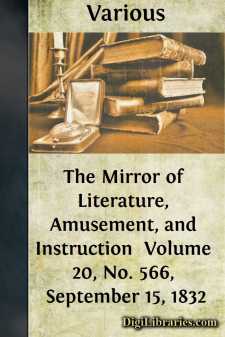Categories
- Antiques & Collectibles 13
- Architecture 36
- Art 48
- Bibles 22
- Biography & Autobiography 813
- Body, Mind & Spirit 142
- Business & Economics 28
- Children's Books 16
- Children's Fiction 13
- Computers 4
- Cooking 94
- Crafts & Hobbies 4
- Drama 346
- Education 46
- Family & Relationships 57
- Fiction 11829
- Games 19
- Gardening 17
- Health & Fitness 34
- History 1377
- House & Home 1
- Humor 147
- Juvenile Fiction 1873
- Juvenile Nonfiction 202
- Language Arts & Disciplines 88
- Law 16
- Literary Collections 686
- Literary Criticism 179
- Mathematics 13
- Medical 41
- Music 40
- Nature 179
- Non-Classifiable 1768
- Performing Arts 7
- Periodicals 1453
- Philosophy 64
- Photography 2
- Poetry 896
- Political Science 203
- Psychology 42
- Reference 154
- Religion 513
- Science 126
- Self-Help 84
- Social Science 81
- Sports & Recreation 34
- Study Aids 3
- Technology & Engineering 59
- Transportation 23
- Travel 463
- True Crime 29
The Mirror of Literature, Amusement, and Instruction Volume 20, No. 566, September 15, 1832
by: Various
Categories:
Description:
Excerpt
BOLSOVER CASTLE
Bolsover is a populous village on the eastern verge of Derbyshire upon the adjacent county of Nottingham; and but a short distance from the town of Chesterfield. The Castle occupies the plain of a rocky hill that rises abruptly from the meadows. The building is of great extent, and, from its elevated situation, it is a landmark for the surrounding country.
Bolsover has been the site of a castle from the Norman Conquest to the present time; but, of the first fabric of this description not a single vestige now remains. At the Domesday survey it belonged to William Peveril, lord of Derbyshire, in whose family it remained for three generations. King John, when Earl of Moreton, became the possessor of Bolsover; but, during his continuation with Longchamp, bishop of Ely, it became the property of that prelate. Subsequently it again reverted to John, who, in the eighteenth year of his reign, issued a mandate to Bryan de L'Isle, the then governor of Bolsover, to fortify the castle and hold it against the rebellious barons; or, if he could not make it tenable, to demolish it. This no doubt was the period when the fortifications, which are yet visible about Bolsover, were established.
In the long and tumultuous reign of Henry III., this castle still retained its consequence. William, Earl Ferrars, had the government of it for six years: afterwards it had eleven different governors in twice that term. It is not necessary to trace the place through all its possessors. In the reign of Henry VIII. it was the property of Thomas Howard, the first Duke of Norfolk. On the attainder of his son, the castle escheated to the crown. Shortly afterwards it was granted to Sir John Byron for fifty years. In the reign of James I., Gilbert Talbot, Earl of Shrewsbury, was the owner of Bolsover. In the year 1613, he sold it to Sir Charles Cavendish, whose eldest son William, was the first Duke of Newcastle, a personage of great eminence among the nobility of his time, and in high favour at court. He was sincerely attached to his royal master, Charles I., whom he entertained at Bolsover Castle, on three different occasions, in a style of princely magnificence. On the king's second visit here, where he was accompanied by his queen, upwards of 15,000l. were expended. The Duchess of Newcastle, in her Life of the Duke, her husband, says, "The Earl employed Ben Jonson in fitting up such scenes and speeches as he could devise; and sent for all the country to come and wait on their Majesties; and, in short, did all that even he could imagine to render it great and worthy of their royal acceptance." It was this nobleman who erected the edifice which is now in ruins. Mr. Bray, in his Tour in Derbyshire, observes: "This place was seized by the Parliament after the Duke went abroad, and was sold and begun to be pulled down, but was then bought by Sir Charles, the Duke's youngest brother, and so restored to the family."
The present castle was built at different periods. The north-east end, which was erected by Sir Charles Cavendish, about the year 1613, is the oldest....












